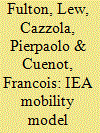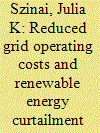| Srl | Item |
| 1 |
ID:
091517


|
|
|
|
|
| Publication |
2009.
|
| Summary/Abstract |
The IEA published "Energy Technology Perspectives" (ETP) in June 2008. That document reports on IEA scenarios for baseline and low-CO2 alternative scenarios to 2050, across the energy economy. The study included creating scenarios for transport, using the IEA Mobility Model (MoMo). This paper reports on the transport-related ETP scenarios and describes the model used in the analysis. According to the ETP Baseline scenario, world transport energy use and CO2 emissions will more than double by 2050. In the most challenging scenario, called "BLUE", transport emissions are reduced by 70% in 2050 compared to their baseline level in that year (and about 25% below their 2005 levels). There are several versions of the BLUE scenario, but all involve: a 50% or greater improvement in LDV efficiency, 30-50% improvement in efficiency of other modes (e.g. trucks, ships and aircraft), 25% substitution of liquid fossil fuels by biofuels, and considerable penetration of electric and/or fuel-cell vehicles. In the second half of this paper, an overview of the MoMo model is provided. Details on the complete analysis are contained in the ETP 2008 document, available at www.iea.org. Details of the LDV fuel economy analysis are contained in a separate paper in this collection.
|
|
|
|
|
|
|
|
|
|
|
|
|
|
|
|
| 2 |
ID:
169845


|
|
|
|
|
| Summary/Abstract |
Widespread adoption of plug-in electric vehicles (PEVs) and renewable energy (RE) can help to jointly decarbonize the transportation and electricity sectors. Previous studies indicate strategies to manage PEV charging facilitate integration of RE into electricity grids, but the value of such strategies at scale is unclear because electricity markets and PEV charging have been inadequately represented together. This analysis focuses on the state of California in 2025, and improves on prior work by linking high-resolution mobility and grid dispatch models to quantify the value of managed charging under a 50% RE grid and PEV adoption scenarios up to California's 5 million vehicle target. Even after accounting for practical charging and grid constraints, 0.95 to 5 million “smart” charging PEVs avoid $120 to $690 million in California grid operating costs annually (up to 10% of total costs) and reduce RE curtailment up to 40% relative to unmanaged PEVs. Overnight time-of-use (TOU) charging provides similar cost savings but increases curtailment. Both of these managed strategies defer system infrastructure expansion at the 5 million PEV deployment. The results suggest residential smart charging complemented by TOU tariffs with added daytime periods are policies with most potential to advance California's dual PEV and RE goals.
|
|
|
|
|
|
|
|
|
|
|
|
|
|
|
|